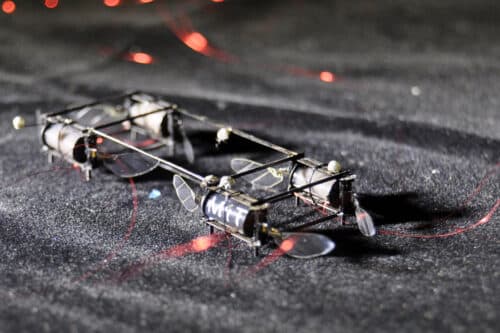MIT researchers have created insect-scale robots that can track motion and have the ability to communicate!

Taking inspiration from nature, they created electroluminescent soft artificial muscles that enable flying, insect-scale robots. When the robots fly, the tiny artificial muscles that drive their wings generate a coloured light. The robots may be able to converse with one another because of this electroluminescence. Robots may use lights to signal others and call for assistance if they were deployed on a search and rescue operation inside a collapsed building, for example.
These paper-clip-sized microscale robots are one step closer to flying on their own outside of the lab thanks to their ability to generate light. Since these robots are too light to carry sensors, researchers must track them using large infrared cameras that are ineffective in the outdoors. They’ve now demonstrated that with just three smartphone cameras and the light the robots emit, they can be tracked precisely.
“If you think of large-scale robots, they can communicate using a lot of different tools — Bluetooth, wireless, all those sorts of things. But for a tiny, power-constrained robot, we are forced to think about new modes of communication. This is a major step toward flying these robots in outdoor environments where we don’t have a well-tuned, state-of-the-art motion tracking system,” says Kevin Chen, who is the D. Reid Weedon, Jr. Assistant Professor in the Department of Electrical Engineering and Computer Science (EECS), the head of the Soft and Micro Robotics Laboratory in the Research Laboratory of Electronics (RLE), and the senior author of the paper.
The artificial muscles are actually durable actuators that are made by alternating ultrathin layers of elastomer and carbon nanotube electrode in a stack and then rolling it into a squishy cylinder. The researchers added electroluminescent zinc sulphate particles to the elastomer to create a glowing actuator. The light colour can be altered by modifying the zinc particles’ chemical composition. For the actuators they constructed, the researchers created green, orange, and blue particles; each actuator emits a single solid colour.
In order for the actuators to generate multiple colours and patterns of light, they also made adjustments to the fabrication process. The top layer was covered with a small mask by the researchers, who then added zinc particles before curing the actuator. To produce a light pattern that spells out M-I-T, they went through this procedure three times with various masks and coloured particles.








